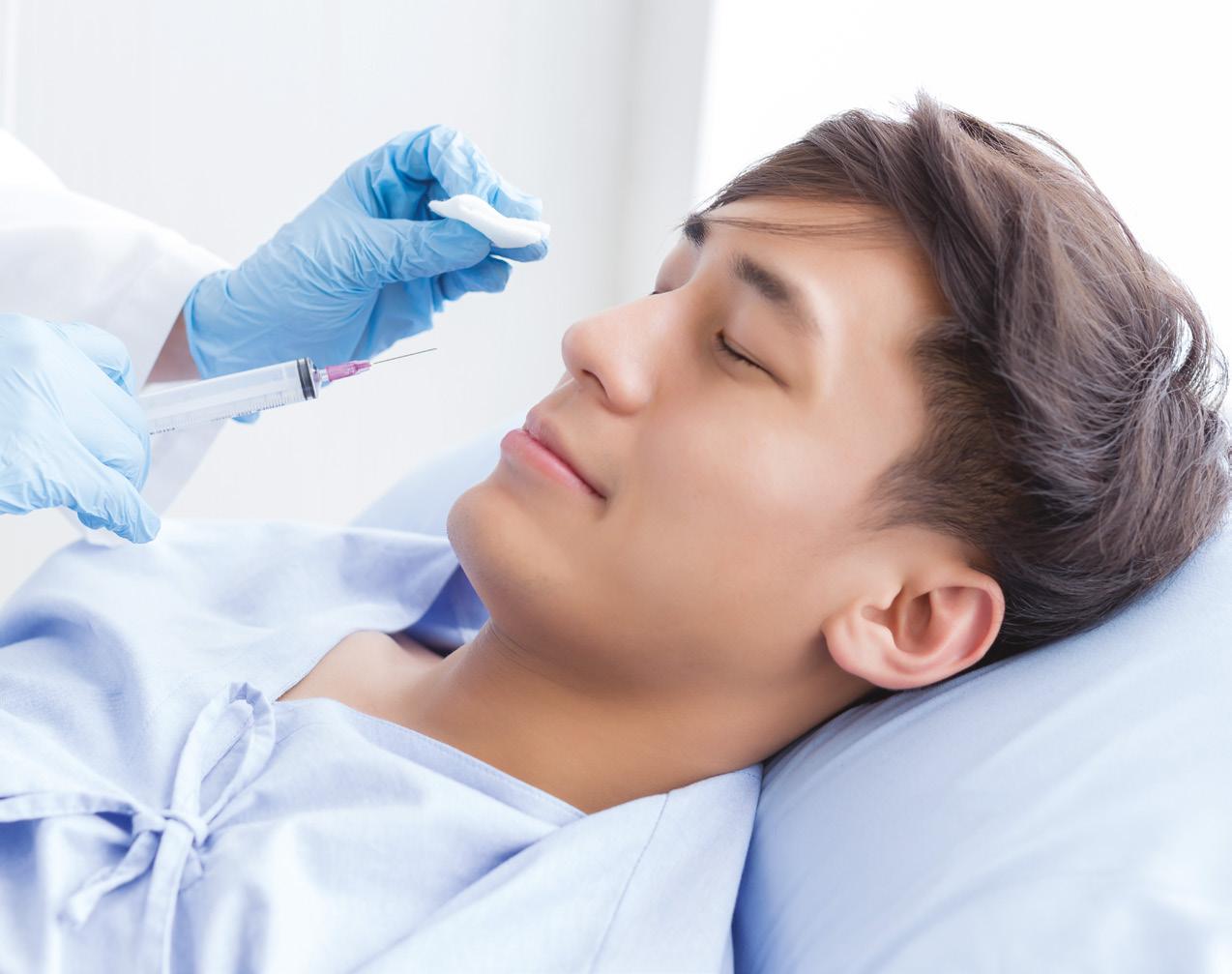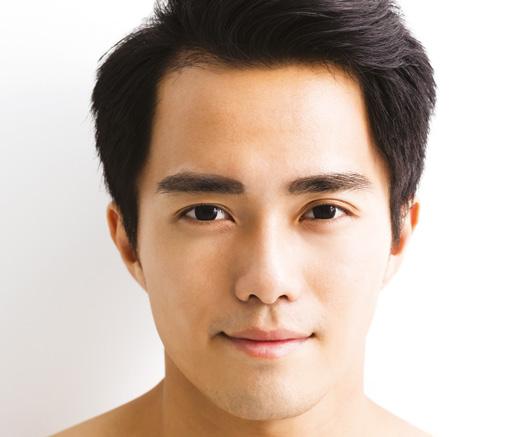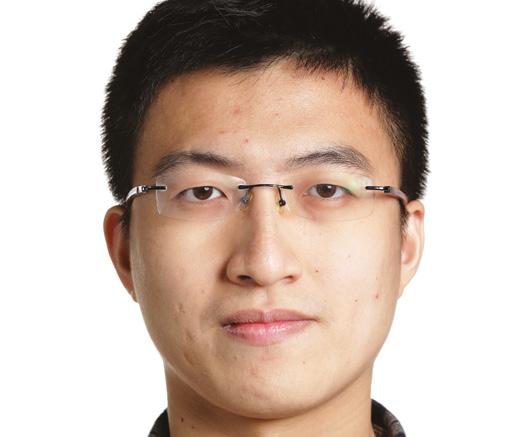
7 minute read
Understanding Asian Men
According to a report conducted in 2018 by the American Society of Plastic Surgeons, men had a total of 1.3 million cosmetic procedures (1.1 million minimally invasive and 215,000 surgical). Since 2017, 1.2 million Asian Americans have had procedures, highlighting a 1% increase. The top three minimally-invasive procedures included botulinum toxin type A injections, laser hair removal and microdermabrasion.1 This article will explore the demand for cosmetic procedures amongst East Asian men, the aesthetic ideals for this cohort and some practical tips for treatment using injectables. Increasing demand for cosmetic procedures In China, men account for 15% of its sizeable aesthetic medicine industry.2 The number of male patients who request cosmetic procedures, particularly non-surgical procedures, are increasing internationally.3-5 This necessitates an understanding of their motivations, expectations and the psychosocial science when it comes to male aesthetics.
The increased demand for cosmetic procedures among East Asian men has been linked to various factors. These included availability, normalisation and acceptance in society, enhanced self-confidence for both personal and professional life, workplace competitiveness, social and emotional competence, attractiveness, and youthfulness.6-10 Male attitudes towards cosmetic surgery are affected by low body image satisfaction, which is impacted by watching television and the use of social media platforms.11,12 However, it has also been reported that social media and television increase the acceptance of surgical and non-surgical procedures for both men and women of Asian origin to enhance or alter their physical appearance. Furthermore, there is an increasingly popular male beauty culture that includes male beauty products, cosmetic and skincare lines aimed at men, and male modelling agencies, which could also be having an impact.13,14 Attractiveness of East Asian men The impact of male facial masculinity on the Dr Souphiyeh Samizadeh outlines East Asian perception of personality and attractiveness male facial features and presents the current has been studied extensively in the context of evolutionary biology and reproductive strategy. popular treatments for this cohort Masculine facial features include a large jaw, prominent brow ridges, prominent chin and cheekbones, and a longer lower face.15-17 Other attractive features on men included clear skin, tattoos and tidy eyebrows, an obtuse jawline, a thin face, a round chin, and an elevated nose bridge. Generally speaking, masculine facial features have been positively associated with various attributes, including testosterone levels, immunocompetence, health, and partner choices;15-18 however, it has also been reported that women usually prefer these facial features for short-term relationships and more feminine male faces are preferrable for long-term relationships.18 In addition to perceived dominance, hypermasculine faces are often associated with ‘coldness’ or ‘dishonesty’.19 Amongst females, masculine facial features appear to be differentially valued depending on such factors as the phase of the menstrual cycle/ hormone levels (the hormonal theory of facial attractiveness) and the mating strategy.20,21 A study in 2010 reported that across 30 countries, independent of wealth and mating strategies, the preference for masculinity increased as the population’s national health decreased.22 Previous studies published on the ideals of beauty among Chinese individuals and aesthetic practitioners have reported that both men and women preferred The skeletal structure of the East Asian an obtuse jawline for both sexes and a round narrow chin.23,24 These features represent a face results in a wide bizygomatic more feminine male face (Figure 1). An unpublished online survey involving 643 and bigonial width, which leads to a Chinese participants showed that the majority of female participants’ preferences for male ‘square’ lower face and a wider, shorter faces was influenced by current famous media or social media influencers.25 The female face in comparison to Western skulls participants preferred a less prominent jawline in Chinese men, while Chinese men and women rated more feminine, Chinese and Caucasian male faces as most attractive and hypermasculine faces as the least attractive.
Advertisement
Top tips for success with injectables Treating East Asian faces requires a thorough understanding of the differences in ideals of beauty and beliefs, possible differences in anatomy and of the existing skeletal and soft tissue morphology. For example, different injection techniques may be required for botulinum toxin A and dermal fillers. In my experience, the frown line and forehead pattern are usually different from the most frequently recognised patterns taught and observed in Caucasians, hence require modified injection technique, dosage and pattern. Presentation of ‘bunny lines’ is very common in East Asians due to the nasal anatomy and morphology, and the interaction of the relevant muscles with the glabellar complex muscles.
My top tips when treating East Asian men: 1. Ask the patient their beauty ideals and facial shape/features they desire. They may be able to show their expectations using photos. 2. When treating the jawline, consider that East Asian males do not often like a dominant square jaw angle and chin. 3. Consider all facial features for balance and harmony. 4. Ask regarding the patient’s belief in facial physiognomy as this may impact treatment planning. 5. Do not just jump straight into injectables – clear blemishfree skin is highly regarded by these individuals. 6. Reduction of size of masseters using botulinum toxin is common but warn patients regarding changes in facial shape and bite force post injection. 7. Gain extensive expertise before performing non-surgical rhinoplasty (a popular request). This is important for all ethnicities. In this population, the nasal morphology and amount of dermal filler required for modification of the nose require further training and risk assessment. 8. Take note when injecting botulinum neurotoxin and dermal fillers that arched eyebrows are not usually desirable. In addition, over-treatment of the forehead area (which may equate to a normal treatment dosage for a Caucasian man’s forehead), could result in eyebrow ptosis and hence further lowering of the eyelids and vision compromise. 9. Consider that a smooth, mildly convex forehead is usually desirable, so take note when using dermal fillers for the forehead area. Accurate and artistic placement of dermal fillers can help balance and harmony of the face. 10. Do not over-treat and over-fill (especially in the jawline).
Although many participants confirmed that their preference for facial attractiveness was influenced by current famous characters from film and social media, they did not necessarily want to look this way. It has been previously reported that British and Japanese women prefer a more feminised male face.24 On the other hand, other research reported that homosexual men usually prefer masculine male faces and data suggests the attractiveness judgement of same-sex faces by homosexuals was not the same as those of heterosexual individuals of the opposite sex.26 Another study examined preferences for masculine features in faces, bodies, voices, and personality characteristics among homosexual men in China and reported preferences for masculinity among all four domains.23 The preference and quest for clear skin has its roots in Chinese culture and tradition. A fair, clear complexion has been associated with wealth and affluence.10,11 This explains the large demand for skincare and laser devices to improve the skin’s appearance. The skeletal structure of the East Asian face results in a wide bizygomatic and bigonial width, which leads to a ‘square’ lower face and a wider, shorter face in comparison to Western skulls27-29 The overly prominent zygomatic arches in the East Asian facial structure, along with the delicate central face topography (a small nose with a retruded forehead and chin), results in an imbalance and makes the face appear ‘overly rough, aggressive, and masculine’.30,31 Therefore, this has led to an increased demand by men for facial contouring surgery.31,32 Furthermore, non-surgical procedures are very popular in Asia. Taking into account the above findings, facial structure and morphology of East Asian men, the focus of injectable treatment is on facial contouring and anterior projection of the face.
Summary This information is significant to aesthetic practitioners, not only in China and East Asia, but internationally as the Chinese market is part of the new increasing middle-class that is slowly becoming wealthier. These individuals either immigrate or travel abroad to seek cosmetic procedures. Aesthetic practitioners can increase their understanding of ideals within facial beauty among different nations, perceptions of attractiveness, psychological factors associated with the perception, and trends/changes over time. As such, the development of tailored communication, psychological skills training and treatment plans are needed to achieve results.


Figure 1: The left shows an example of an East Asian man with more obtuse jawline, representing a more feminine male face. The right is an example of an East Asian male with a wide bizygomatic and bigonial width, causing a ‘square’ lower face and a wider, shorter face compared to Western Caucasian faces.
Dr Souphiyeh Samizadeh is a visiting associate professor, the founder of the Great British Academy of Aesthetic Medicine, and the clinical director of Revivify London clinic. She is an honorary clinical teacher at King’s College London, visiting clinical fellow at University College London. She practices and teaches in the UK and in China. Dr Samizadeh has multiple published peer-reviewed papers, frequently presents at national and international conferences and trains aesthetic doctors, dermatologists and surgeons worldwide. Qual: BDS, BSc, MJDF, RCS(Eng)PGCert (Clin Edu), MSc(Aesthetic Medicine), FHEA
VIEW THE REFERENCES ONLINE! WWW.AESTHETICSJOURNAL.COM










